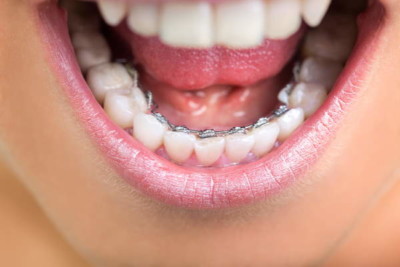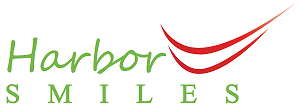Contents: How it works? | Pros and Cons | How much cost? | Appointment | FAQs
 Braces have been the only method used to correct defects in a person’s teeth. It is not only used for teeth straightening but also to close gaps. These are also used to treat abnormalities with the upper and lower jaws underbites, overbites, and crossbites.
Braces have been the only method used to correct defects in a person’s teeth. It is not only used for teeth straightening but also to close gaps. These are also used to treat abnormalities with the upper and lower jaws underbites, overbites, and crossbites.
Lingual braces are similar to traditional braces. The distinction is that the braces’ brackets, ligatures, and other components are used on the lingual side of the teeth. Because of it being hidden, it has become a popular choice for teens and adults. Have a look at our options for Ortho treatments at Huntington Beach, CA.
Few of the Lingual orthodontic brackets manufacturers
-
Ormco
-
Dentaurum
-
Hubit
How do they work?
Lingual braces are similar to traditional metal braces in regards to how they work, however they are placed on the tongue side, as opposed to Dental braces teens. However, positioning it on the tongue side may cause issues not only for the patient but also for the orthodontist. One evident problem is a lack of space between the top and the bottom sets of teeth for the braces to be supported. Continue reading to learn more about this treatment:
- Clinical Evaluation – When deciding if hidden braces are the best for your treatment, our expert dentists will conduct a detailed examination of your teeth and evaluate the severity of your case. He will also examine the study models and radiographic images of your teeth to create a customized treatment plan for each patient.
- Making Impressions of your Teeth – We will carefully clean your teeth prior to taking impressions and will use a specialized scanner to create 3D impressions of your upper and lower jaws.
- Cast and set-up – The technician produces a case and modifies it according to the dentist’s instructions to create a setup for your case. The set-up is a physical mock-up of your teeth in perfect alignment.
- Fabrication of Treatment Plan -The mock-up dimensions are digitized using specialized 3D software. A special CAD (Computer-Aided Design) software is used to design brackets specifically for your teeth. Brackets for each tooth are custom-designed separately.
- Production – A computer-aided manufacturing (CAM) software (computer-aided machining) in the computer uses this design data to produce the brackets using numerically controlled(NC) milling machines. Robotic bending is used, again under computer control, to prepare the archwire.
- The applicator tray– The fabricated brackets are embedded into an applicator tray, a stent that should perfectly fit over your teeth and hold the brackets in exact alignment to perform the bonding procedure. The hardware is then sent to the dentist. The attachment of brackets will be done on the next appointment and it involves the following steps:
- Preparation of the teeth – The teeth are cleaned and thoroughly cleaned to allow proper bonding.
- Cement application – A cement is placed over the brackets in the applicator tray.
- Bonding – The applicator tray is pressed precisely against the teeth and all the brackets of the jaw (either upper jaw or the lower jaw) are bonded simultaneously.
- Tray removal – When the cement has cured, the dentist will break away the tray which leaves the brackets firmly attached to the teeth. Any excess bonding material will be scraped off.
- The archwire – The archwire can then be placed. Ligatures are not needed.
Length of treatment
The duration of treatment varies according to the patient’s circumstances, but it is typically 1-3 years. After the realignment has been done, these are then removed. You’ll be fitted with a retainer (removable or permanent) and instructed to wear it for several months to ensure that your bite does not revert to its previous state. Get a closer look at how Clear braces adult can also make your smile even.
Taking care of Your Lingual Braces
Due to their location on the tongue side of the mouth, they require additional attention and care. We recommend these things to ensure a worry-free treatment.
- Maintain good oral hygiene – Maintaining proper oral hygiene aids in the prevention of gum disease and tooth decay. This involves the following steps:
- Brush your teeth twice a day and spend at least two minutes cleaning your teeth evenly.
- Use only a soft toothbrush with rounded bristles to clean the gum line and the teeth and an inter dental toothbrush to clean the gaps. You can also use an oral irrigation device to thoroughly clean the teeth.
- Daily flossing after every meal will also go a long way to ensure excellent oral health.
- Protecting oral soft tissues – When the braces irritate the tongue, apply dental wax on the insides of the teeth particularly where it irritates and hurts the soft tissues.
- Regular Visits – Aside from your regular appointments, you need to visit your dentist every six months for prophylaxis and teeth cleaning.
- Diet Management – avoid sticky, chewy, and hard foods, including raw vegetables like carrots and apples. Sticky and hard foods can dislodge your brackets.
Pros and Cons
Lingual braces have a number of advantages over other kinds of teeth straightening devices. It also has its limitations. Here is a quick overview that will assist you in selecting the best cost-effective and efficient orthodontic treatment choice for you.
Pros
- Better Aesthetics – The biggest advantage is it is nearly invisible compared to other types of braces which make for a more casual look. Only a closer examination will reveal its presence.
- Lingual braces are less visible than clear plastic aligners as the latter may sometimes disclose their presence and give off a sheen.
- Lingual braces give the dentist better control over individual teeth’ movement.
Cons
- Potential for tongue irritation – As they are placed on the inside of the teeth, they come in contact with the tongue and may cause it to be irritated, which can lead to pain in the area when swallowing or speaking. They can also restrict the movement of the tongue.
- Speech problems – Your tongue will need to touch against the teeth and produce certain sounds. With the brackets placed where the tongue used to touch, you may not be able to produce sounds correctly – well at least during the first few weeks.
- Cleaning care – Since it is located on the inside, lingual braces have special demand in regular hygiene care.
- Application is complicated – Placing the braces behind the teeth will have limited visibility and it needs more time and attention to install. A specialist training is needed on the part of the dentist.
- Getting used to – It takes more time to get used to lingual braces than to the normal visible braces.
More “Hidden” Advantages
-
Shortened treatment time
-
Braces are invisible!
-
Customized to your Bite
-
Affordable Treatment thru Advanced Technology
Lingual braces cost
 Health insurance plans won’t normally cover braces for patients over 18 years old, but there are supplementary plans available. Expenses on braces are tax-deductible when it exceeds a certain limit. In any other insurance, be sure to discuss the best coverage percentage and lifetime maximums. The level of coverage differs significantly, but the most frequent figure is 50% with a lifetime maximum of $1500 for each kid. Our nearby office benefits coordinator can assist you in deciphering your insurance and offering numerous payment choices, including our in-house zero-interest financing, to assist you in obtaining this life-changing therapy for your kid or yourself.
Health insurance plans won’t normally cover braces for patients over 18 years old, but there are supplementary plans available. Expenses on braces are tax-deductible when it exceeds a certain limit. In any other insurance, be sure to discuss the best coverage percentage and lifetime maximums. The level of coverage differs significantly, but the most frequent figure is 50% with a lifetime maximum of $1500 for each kid. Our nearby office benefits coordinator can assist you in deciphering your insurance and offering numerous payment choices, including our in-house zero-interest financing, to assist you in obtaining this life-changing therapy for your kid or yourself.
Check out our Lingual Braces California services.
How much do Hidden Braces Cost?
Lingual braces will cost between $8,000 to $13,000. Lingual Braces are slightly more expensive on average than Invisalign or transparent braces. Insurance companies may cover up to for Lingual concealed braces placed inside the teeth.
Experienced expert at Malocclusion correction
What orthodontic problems can it treat?
Cross Bite
Crossbites are a kind of malocclusion wherein the top teeth connect the inside of the bottom teeth. This form of misalignment can impact a single tooth, a group of teeth, or both teeth. Know more about worn tooth enamel.
Crossbites can result in the following complications:
- Bone loss
- Less attractive smile
- Weak chewing patterns
- When the teeth have premature wear
- Gum disease
- Asymmetrical jaw development
For Open Bite
While the top jaw is pushed upward, the maxilla and mandible jaws do not connect when the mouth is closed.
If left untreated, this problem can result in the following:
- A less attractive smile
- Premature wear of the molars
- Jaw joint dysfunction
For Overbite
This form of malocclusion occurs when the top and bottom teeth overlap. When an overbite is extreme, it can result in asymmetrical growth of both the front and lower teeth. It may also have an effect on the growth of the bone that supports the teeth.
An overbite might result in the following complications:
- Abnormal deterioration of the lower portion of the mouth
- Bottom anterior portion biting into the gum tissue, which may result in periodontal disease.
Underbite correction
When you close your mouth, the bottom teeth hit the front of the teeth. In most cases, this is a problem of the lower jaw being far too forward. This malocclusion is produced by widened lower incisors, pointed rear incisors, or a missing upper part, or a mixture of these conditions.
Underbite must be rectified immediately for the following reasons:
- It prevents the correct functions of the mouth
- Your smile is less attractive
- Can cause jaw-joint dysfunction
Gaps in teeth – Diastema
Gapped teeth, also known as diastema, is a dental disorder in which two or more teeth have a noticeable space between them. It is a common condition between two front incisors. Diastem is a common type of minor misalignment and Lingual braces will be able to treat it.
A tooth gap is a very minor dental condition that normally affects only a few teeth and is unrelated to bite misalignment or other difficulties. Lingual braces can be used to address it.
An extreme case of misalignment can also get treated with Lingual braces.
Before receiving treatment with lingual braces, the American Academy of Cosmetic Dentistry (AACD) suggests that you request before and after photographs, testimonials, and evidence of education and training from your dentist.
FAQs for Teeth Correction
Are lingual braces worth it?
Lingual braces are a fantastic alternative if you require braces but do not want them to be visible. Unlike conventional braces, these are less apparent because they are linked to the rear surfaces of the teeth. This, however, raises the treatment's cost, making it much more costly than clear braces or even Invisalign. It is entirely up to you to choose whether the treatment will ultimately benefit your health. Schedule an appointment at our Harbor Smiles office to learn if this treatment is right for you.
Does dental insurance cover hidden braces?
Lingual braces are covered by several dental insurance plans. Ascertain the specifics of your policy by contacting your insurance provider. To determine the cost of your lingual braces with insurance, please visit .
Do invisible braces take longer?
The average person wears braces for 1-2 years before achieving the desired outcomes. The duration of time that you must wear lingual braces is comparable to that of regular braces.
Lingual Hidden Braces Nearby
Lingual braces provide the same advantages and performance as regular braces when it comes to reducing gaps, straightening teeth, and correcting bites; however, they are fitted on the non-visible part of your teeth, making them nearly invisible. Harbor Smiles at Huntington Beach provides lingual braces to the California community for straighter teeth and a more wonderful smile without conspicuous metal brackets and wires. Set up a visit at Huntington Beach, California to determine if this treatment choice is right for you.
Committed to a Comfortable Malocclusion Care Experience
Harbor Smiles provides aligners for adults and adolescents who want perfectly aligned teeth. Make an appointment at Huntington Beach, CA to learn about your alternatives for achieving straighter teeth.
Lingual Braces Near Me
When picking a dental specialist, consider one that is close to your home, workplace, or school, as this will save you money and effort. Expect a few treatments or follow-up consultations in addition to your regular appointments in the future. Having a dental clinic close by might make life easier. Furthermore, search for a professional with a positive reputation for lingual braces and one with whom you feel comfortable working with. Schedule an appointment with Dr. Manali Patel DDS.
Source:
- Can adults wear braces? (2007)
- Paying for treatment. (2019). aaoinfo.org/blog/parent-s-guide-post/orthodontic-treatment-cost/
Related Posts:
